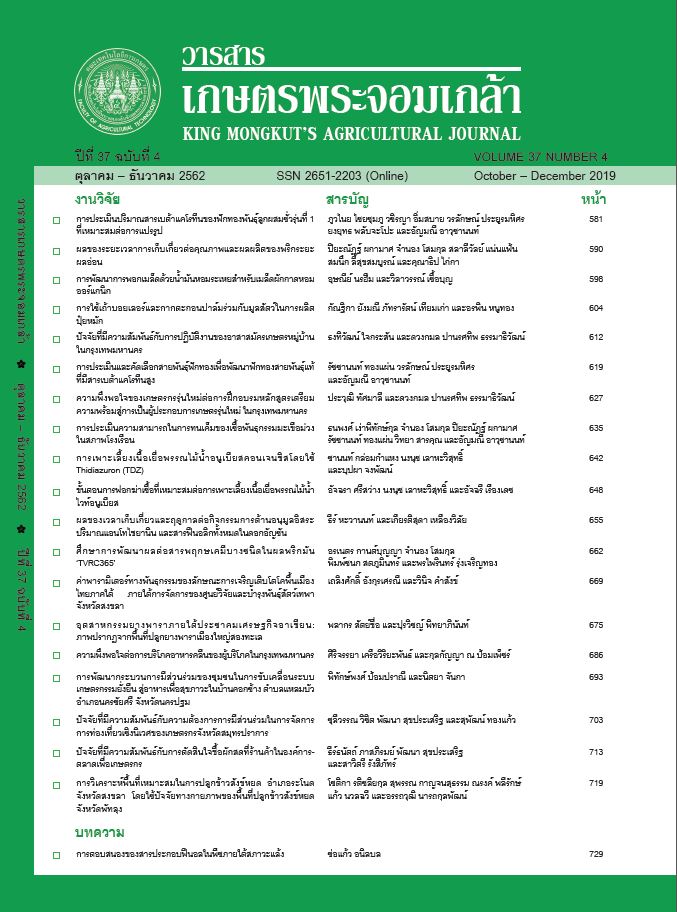ผลของเวลาเก็บเกี่ยวและฤดูกาลต่อกิจกรรมการต้านอนุมูลอิสระ ปริมาณแอนโทไซยานิน และสารฟีนอลิกทั้งหมดในดอกอัญชัน
Main Article Content
บทคัดย่อ
อัญชัน (Clitoria ternatea L.) เป็นพืชที่มีสรรพคุณทางยาและเป็นพืชให้สีที่มีการใช้ประโยชน์อยู่ในหลายประเทศ
มีการศึกษาศักยภาพและการใช้ประโยชน์ของสารทุติยภูมิที่สกัดได้จากส่วนต่าง ๆ ของอัญชันอย่างกว้างขวาง แต่การพัฒนาพันธุ์ให้มีคุณสมบัติทางพฤกษเคมีที่ดีขึ้นนั้นยังมีอยู่อย่างจำกัด การศึกษาคุณลักษณะทางพฤกษเคมีในเชื้อพันธุกรรมอัญชันจะทำให้ได้ข้อมูลพื้นฐานสำหรับการจัดการและใช้ประโยชน์ของเชื้อพันธุกรรมในการพัฒนาพันธุ์ต่อไป คุณสมบัติทางพฤกษเคมีในพืชอาจมีความผันแปรเนื่องจากสภาพแวดล้อม ซึ่งยังมีการศึกษากันน้อยในอัญชัน จึงทำการศึกษาโดยมีวัตถุประสงค์เพื่อให้ทราบว่าช่วงเวลาของวันและฤดูกาลในการเก็บเกี่ยวมีผลต่อคุณสมบัติทางพฤกษเคมีในดอกอัญชัน โดยศึกษากับเชื้อพันธุกรรมอัญชันจำนวน 14 หมายเลข เก็บเกี่ยวดอกใน 3 ช่วงเวลาของวัน คือ เช้า 8:00-9:00 น. กลางวัน 12:00-13:00 น. และบ่าย 16:00-17:00 น. ใน 2 ฤดู คือฤดูร้อน ระหว่างเดือนเมษายน-พฤษภาคม และฤดูฝน เดือนสิงหาคม 2560 พบว่า ช่วงเวลาของวันมีผลต่อกิจกรรมสารต้านอนุมูลอิสระ (FRAP assay) โดยดอกที่เก็บเกี่ยวในช่วงเช้ามีค่า FRAP สูงที่สุด ใกล้เคียงกับช่วงบ่าย
แต่มากกว่าช่วงกลางวัน พบอิทธิพลร่วมของช่วงเวลาของวันและฤดูกาลต่อฤทธิ์กำจัดอนุมูลอิสระ (DPPH assay) โดยดอกอัญชันที่เก็บเกี่ยวในช่วงบ่ายในฤดูร้อนมีค่า DPPH สูงที่สุด แตกต่างจากดอกที่เก็บเกี่ยวในช่วงกลางวันในฤดูเดียวกันที่มีค่า DPPH ต่ำที่สุด นอกจากนี้ยังพบว่าปริมาณสารฟีนอลิกและปริมาณแอนโทไซยานินทั้งหมดในดอกอัญชันที่เก็บเกี่ยวในฤดูฝน
มีมากกว่าที่เก็บเกี่ยวในฤดูร้อน
Article Details
วารสารเกษตรพระจอมเกล้า
เอกสารอ้างอิง
Benzie, I.F.F. and J.J. Strain. 1996. The ferric reducing ability of plasma (FRAP) as a measure of “antioxidant power”: the FRAP assay. Anal. Biochem 239: 70-76.
Borochov-Neori, H., Judeinstein, S., Harari, M., Bar-Ya’akov, I., Patil, B.S., Lurie, S., and D. Holland. 2011. Climate effects on anthocyanin accumulation and composition in the pomegranate (Punica granatum L.) fruit arils.
J. Agric. Food Chem 59: 5325-5334.
Brand-Williams, W., Cuvelierm M.E.m and C. Berset. 1995. Use of free radical method to evaluate antioxidant activity.
Lebensm. Wiss. Technol. 28: 25-30.
Cendrowski, A., Scibisz, I., Mitek, M., Kieliszek, M., and J. Kolniak-Ostek. 2017. Profile of the phenolic compounds of Rosa rugosa Petals. J. of Food Qual. https://doi.org/10.1155/2017/7941347 (September 26, 2018).
Chusak, C., Thilavech, T., Henry, C.J., and S. Adisakwattana. 2018. Acute effect of Clitoria ternatea flower beverage on glycemic response and antioxidant capacity in healthy subjects: a randomized crossover trial. BMC Complement Altern. Med. 18: 6.
Cook, B.G., Pengelly, B.C., Brown, S.D., Donnelly, J.L., Eagles, D.A., Franco, M.A., Hanson, J., Mullen, B.F., Partridge, I.J., Peters, M., and R. Schultze-Kraft. 2005. Tropical Forages: an interactive selection tool, [CD-ROM], CSIRO, DPI&F(Qld), CIAT and ILRI, Brisbane, Australia. http://www.tropicalforages.info. (September 26, 2018).
Fantz, P.R. 1977. A monograph of the genus Clitoria (Leguminosae: Glycineae) (Doctoral dissertation). https://archive.org/stream/monographofgenus00fant#page/n0/mode/2up (September 26, 2018).
Kaisoon, O., Siriamornpun, S., Weerapreeyakul, N., and N. Meeso. 2011. Phenolic compounds and antioxidant activities of edible flowers from Thailand. J. Funct. Foods 3: 88-99.
Kamkaen, N., and J.M. Wilkinson. 2009. The Antioxidant activity of Clitoria ternatea flower petal extracts and eye gel.
Phytother. Res. 23: 1624-1625.
Kazuma K., Noda, N., and M. Suzuki. 2003. Flavonoid composition related to petal color in different lines of Clitoria ternatea. Phytochemistry 64: 1133-1139.
Lachman, J., Šulc, M., Faitová, K., and V. Pivec. 2009. Major factors influencing antioxidant contents and antioxidant activity in grapes and wines. Int. J. Wine Res. 1: 101-121.
Lattanzio, V. 2013. Phenolic compounds: Introduction. pp. 1543-1580. In K.G. Ramawat and J-M. Mérillon, eds. Natural Products. Berlin: Springer-Verlag.
Lee, J., Durst, R.W., and R.E. Wrolstad. 2005. Determination of total monomeric anthocyanin pigment content of fruit juices, beverages, natural colorants, and wines by the pH differential method: collaborative study. J. AOAC Int. 88: 1269-1278.
Li, H., Tsao, R., and Z. Deng. 2012. Factors affecting the antioxidant potential and health benefits of plant foods. Can. J. Plant Sci. 92: 1101-1111.
Lu, Y., Du, J., Tang, J., Wang, F., Zhang, J., Huang, J., Liang, W., and L. Wang. 2009. Environmental regulation of floral anthocyanin synthesis in Ipomoea purpurea. Molecular Ecology 18: 3857-3871.
Makasana, J., Pillai, V., Sharma, A., Dholakiya, B.Z., Gajbhiye, N.A., and R. Saravanan. 2016. Effect of seed treatment on germination and flavonoids diversity in accessions of butterfly pea (Clitoria ternatea). Indian J. Agr. Sci. 86(12): 1553-1558.
Mlodzinska, E. 2009. Survey of plant pigments: Molecular and environmental determinants of plant colors. Acta Biol. Cracov. Bot.
51: 7-16.
Mukherjee, P.K., Kumar, V., Kumar, N.S., and M. Heinrich. 2008. The Ayurvedic medicine Clitoria ternatea - From traditional use to scientific assessment. J. Ethnopharmacol. 120: 291-301.
Nair, V., Bang, W.Y., Schreckinger, E., Andarwulan, N. and L. Cisneros-Zevallos. 2015. Protective role of ternatin anthocyanins and quercetin glycosides from butterfly pea (Clitoria ternatea Leguminosae) blue flower petals against lipopolysaccharide (LPS)-induced inflammation in macrophage cells. J. Agric. Food Chem. 63: 6355-6365.
Swain, T. and W.E. Hillis. 1959. The phenolic constituents of Prunus domestica. I. - The quantitative analysis of phenolic constituents. J. Sci. Food Agric. 10(1): 63-68.
Terahara, N., Oda, M., Matsui, T., Osajima, Y., Saito, N., Toki, K., and T. Honda. 1996. Five new anthocyanins, ternatins A3, B4, B3, B2, and D2, from Clitoria ternatea flowers. J. Nat. Prod. 59: 139-144.
Tulukcu, E., Sagdic, O., Albayrak, S., Ekici, L., and H. Yetim. 2009. Effect of collection time on biological activity of Clary sage
(Salvia sclarea). J. Appl. Bot. Food Qual. 83(1): 44-49.
Wrolstad, R.E. 1976. Color and pigment analyses in fruit products. Stations Bull. pp. 621. Agricultural Experiment Station. Corvallis: Oregon State University.
Yalcin, H., Kavuncuoğlu, H., Tulukcu, E., and Z. Eroğlu. 2017. The effect of harvest time on the bioactive properties and volatile components of lavender (Lavandula officinalis). Qual. Assur. Saf. Crop. 9: 275-283.


